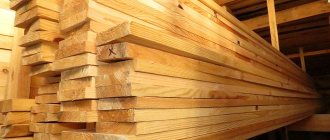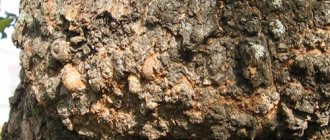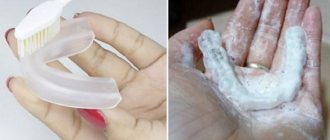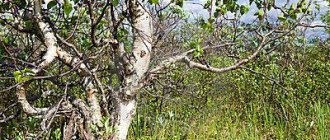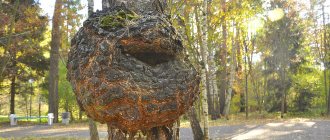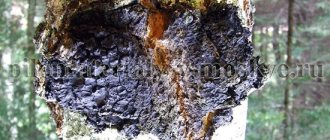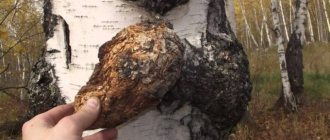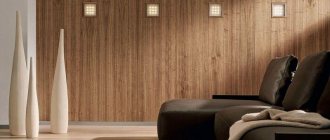A burl is also called a “witch’s broom” - it is a small formation on a tree of a benign nature. Basically it has the form of a drop from which thin branches grow, collected in a bunch. In the cross section, you can observe a structure of striking knots. Processing the burl is not easy, although it can still be ground and polished. The result of the work has a very attractive appearance.
Some areas of birch burl may have a mother-of-pearl appearance. In industry it is not of particular value, but is quite expensive due to its beauty and uniqueness.
Sometimes burl can be used as a veneer for furniture, but most often it is burl from exotic trees. But birch burl is used to make beautiful boxes, small women’s jewelry or hairpins, and cigarette cases.
Birch burl has a high-quality texture, so a knife with a wooden handle is very beautiful and expensive.
It is impossible to find two identical burls in nature; even the halves differ from each other. They can be seen on many different trees. In our latitudes, birch burl is highly valued. It does not grow large, the maximum diameter is like that of a large plate.
Due to the dense texture, it is difficult to make any design on the mouth guard, and there is no point.
What it is?
Suvel is a resource growth for humans, but for the birch itself it does not mean anything good. This growth appears due to a tree disease (figuratively speaking, due to birch cancer). Usually it is a lump, twisted and braided, without a clear geometric shape.
Another popular name for the growth is svil. And this tree grows 2 or even 3 times faster than the tree itself. In shape it resembles either a drop, or a ball, or something in between. The growth is located around a branch or trunk. On birch, such formations are often found, although it is impossible to say exactly what causes them and why they develop. It is believed that suvel appears due to a fungal attack on the tree. But mechanical injury to the birch cannot be ruled out.
But this growth is called woody bone because the cut of suvel resembles marble stains, with a cross-section and rays characteristic of the material, and thin particles of suvel can even be seen right through. Some similarity with the structure of bone tissue can indeed be discerned. True, the tissue density of the growth is still less - this wood is not as strong as, for example, burl.
It happens that suvel grows to enormous sizes. If you come to the Vatican, you can see a font there, which is made from a single piece of souvel cut from a tree. True, gigantic size does not equal quality of material. Typically, the smaller the birch bone, the brighter and more saturated the internal pattern. But in any case, the internal pattern of the growth is soft, without tweezers or needles.
The inside of the suvel resembles mother-of-pearl – in shade, of course. It can be different, it can be whiter, darker, richer or more faded. Sometimes the inside of the suvel is like amber, it can be browner, pinkish or even greenish. What the shade of the inside of the growth will be depends on where the birch grows, as well as on the subsequent drying of this part of the tree.
By the way, suvel can be provoked. Some people simply tie a birch trunk or a specific tree branch with wire. At the site of the constriction, a bulge is formed, which is created by annual rings. But if caring for nature is a priority, you shouldn’t do this.
Suvel is also an advantageous natural formation because it behaves well when processed. The build-up lends itself well to grinding and is perfectly polished. Finally, the main value of education is that very mother-of-pearl cut that resembles marble. It plays with streaks in the sun, captivates with its texture and even gives birth to some kind of inner light. It is impossible to say for sure, looking at a growth on a birch tree, what it is like inside, but certain predictions can be made.
The more clumsy and steeper the growth, the richer and more interesting its internal pattern.
Properties of the build-up
The causative agents of growth diseases, according to the type of nutrition, are classified as biotrophic parasites. These can be fungi, fungus-like organisms, bacteria, viruses, insects.
Like all types of tumors, growths are formed due to changes in the hormonal balance of the plant and intensive growth of affected tissues and organs due to increased division and/or increased cell growth (hyperplasia and hypertrophy).
Growth, as a type of disease, is quite common. In particular, during the disease of sugar beet curl, caused by the Beet leaf curl virus, growths gradually increasing from the size of a pea to sizes exceeding the size of a root crop are formed on the underground parts of the table beet. Most often they form in the neck area, less often - on the lower parts of the root. The surface of these growths in the initial stage of development of the disease is always smooth. The growth may be hollow inside.
Cap
People call the mouth guard a “witch’s broom.” There really is something repulsive about it, but only if you don’t know what miracle nature has hidden under a thick layer of bark.
What does a cap look like?
Location on the tree Unlike suvel, burls are rare. They usually appear on tree trunks or in the root part. Much less often they form on branches. The basal growths (caporoot) have a flattened shape, while the stem or butt growths more closely resemble a ball, often asymmetrical in appearance. As a rule, the burls are located on one side of the trunk in the form of a characteristic influx; Less common are growths that cover the entire circumference of the tree. There are both single specimens and entire burl colonies covering the tree trunk in small groups.
Formation and structure The fundamental difference between burl and suvel is in the structure. If you look at the burl in cross-section, it will be filled with small woody nodules - these are the so-called dormant buds. While suvel is simply deformed and chaotically intertwined annual rings. Thus, the burl growth represents a kind of reserve bundle of unopened buds, created by nature in reserve. Why exactly? Dendrologists have no consensus on this matter.
Under a thick layer of bark, cap and suvel are practically indistinguishable from each other. The only thing that can give away a burl is the small green branches growing on its surface. This is part of those same dormant buds, only activated for some reason. Without the bark, the difference between burl and suvel becomes obvious. The surface of the burl is covered with cone-shaped convexities, while the suvel is absolutely smooth.
Sizes The sizes of the burls vary greatly: from growths the size of a walnut to truly gigantic formations. The largest documented burl in Russia was found on a flat-leaved birch tree that grew on Sakhalin. Its height was 1.4 m, and its circumference was 10.8 m. The size of the burls depends on the location on the trunk and the type of tree. Root burls are traditionally considered larger, but their extraction becomes a difficult task and is impossible without cutting down the tree. Large burls, weighing 300 kg or more, can often be found on walnuts, downy birch, and Mongolian oak. They grow 3-4 times slower than suvel and are found very rarely.
Texture Burl wood has a characteristic texture, thanks to which it is also quite easy to distinguish it from suvel. On a burl cut, dormant buds seem to be wrapped in numerous layers of wood fibers. Such nodules are somewhat similar to the texture of a “bird’s eye”, but in the mouth guard they are not distributed as evenly. Everything here is chaotic: the buds merge with each other, penetrate each other, are absent in some areas, and accumulate very densely in others. All this creates complex lace abstractions, somewhat reminiscent of a malachite pattern.
READ Where is wood ash used?
Bird's eye (maple wood) and burl texture
The more dormant buds, the more complex and rich the wood pattern. Large burls have fewer buds, so their texture is closer to suvel.
Biological role of mouth guards Both mouth guards and suvel are often called a disease. This position is not entirely scientific, but it cannot be called unequivocally erroneous, at least because the biological role of the growths is still not clear. There are different hypotheses on this matter. For example, the burl is considered as a reserve reserve of buds from which the tree can regenerate, for example, in the event of drought or partial loss of the crown. There is also an opinion that the growths increase the mechanical strength of the trunk, protect it from damage or prevent pathogenic agents from entering it. There are many assumptions, and they are all convincing to varying degrees. However, most dendrologists agree that the ability of trees to form burls has no clear function - it is something of a side effect of evolution that was once more important than it is now.
What causes a growth on a birch tree?
The reasons for the appearance of a growth on a birch tree are different depending on the nature of this growth:
- In the case where the nature of the growth is due to infection of the plant, the cause may be spores of fungi or harmful bacteria;
- The appearance of a burl
(
burl
) is due to the fact that a bud with a new branch cannot break through the thick bark, however, the processes that begin in the tree trunk in connection with growth contribute to the delivery of nutrients instead of the birth of a bud. Accordingly, favorable conditions are created there and more and more buds appear, which also cannot be born; - The cause of the appearance of a growth on the trunk of a plant can also be a fungus or mechanical damage to the trunk.
Thus, the most dangerous for birch are various fungal pathogens. They provoke a large number of tree diseases, including growths. But besides this, they can cause damage to bark and leaves. Much less often, the causes of diseases are bacteria and even less often, pathologies in the development of the tree itself.
However, we must remember that external causes, such as damage to trunks or a polluted environment, make them most vulnerable. Therefore, it is within our power to take care of nature:
- Reduce emissions of harmful substances into the atmosphere;
- Do not hammer nails into trees when relaxing in nature;
- Do not strip living bark from the trunk for crafts;
- Do not injure or damage the trunk.
Perhaps this way we can help the trees not get sick.
Burl texture
- The fabulous natural pattern of burl wood consists of:
- Twisted annual layers, usually pronounced
- Pronounced core of small branches
- Curly complex structure
Maple burl
Each burl, like a human fingerprint, has an exclusive pattern and shape. No, in nature there are no two identical growths, called burls. Moreover, neither in the shape of the growth, nor in its structure.
Immediately after cutting the burl, its rich texture is practically invisible. Burl wood reveals its texture to its fullest extent after sanding, polishing and toning.
Birch burl product
- Stem burls have a more refined texture than root burls.
- Processing burls is difficult due to the large presence of knots and twists.
- The burl, after processing, looks like marble or malachite and has a pearlescent sheen.
The color of burl wood can be brown, milky, pinkish, greenish, depending on the type of tree and where it grows.
Making boxes
Crafts made from birch burl are not inferior in beauty to souvenirs made from wood and even surpass them. Magnificent boxes are often made from this material.
During the work process, the burl boards are carefully connected to each other, making sure that their texture pattern is similar. A very important operation is the manufacture of wooden hinges. This step requires the precise formation of rounded tenons and grooves on the edges of the lid and body of the product. The hinges must fit tightly and accurately. Another difficult operation is drilling holes. In wooden hinges this is easiest to do with thin steel wire. At the next stage, a lock is cut into the box. The product is almost ready. It should only be puttied, thoroughly dried and the surfaces coated with alkaline varnish. After completing these works, the box is treated with polish and wiped with alcohol. The product is polished until the wood acquires and until all the veins of its amazing texture shine brightly.
Suvel
Suvel is growths without dormant buds. Sometimes such formations are called “suvelval” or simply “svil”. Unlike burl, the structure of suvel does not have wood knots, and all the beauty of the texture here is created by chaotically intertwined vessels. From such deformed fibers, an influx in the shape of a ball or drop is formed on the trunk. It grows three to four times faster than burl and is found on trees much more often.
What does suvel look like?
It is quite easy to distinguish suvel from burl. Neither small branches nor buds emerge from it. Under a thick layer of bark, the surface is completely smooth, without conical convexities, like a burl. All the beauty of the texture here is formed by a chaotic strand of intertwined fibers. It does not just flow in light waves, as in some tree species, but gathers into dense folds, bundles, and strands. The beauty of the design is enhanced by a special shimmer that resembles marble, mother-of-pearl or moire pattern. The burl does not have such pronounced overflows.
Suvel changes its appearance more dramatically after finishing. For example, when deeply impregnated with colorless oils and thoroughly polished, wood acquires a special “bone” texture. Because of this, suvel is sometimes even called wood bone. In some rocks, after processing, twisted veins are literally visible through the structure of the material. This effect is highly valued by knifemakers: most often they make knife handles from birch, walnut, and ash.
The density of suvel is lower than that of burl. Moreover, it is an order of magnitude greater than the hardness of stem wood. Processing suvel birch and other species requires certain skills, since, like burl, it is not the most pliable material. But despite all the difficulties, working with him is an incomparable pleasure. Suvel always has a mystery: it is impossible to predict what amazingly beautiful pattern will be revealed after the next pass of the cutter.
Why does a growth called suvel appear?
As a result of external influence on the tree, a fold is formed. Over time, the fold becomes overgrown with tortuous fibers. This is suvel.
There are more suvels on the trees than burls. Under the bark, tree suvels have a smooth surface, and not “pimples”, like burls.
Suveli can have different textures; the predominant shapes include waves, curves, spots, and stripes. After sanding and polishing, the shine and shine of the wood appears.
Suvel ash
Suvel can be of various shades, mainly brown, yellow, gray, slightly greenish, or vice versa with pinkish “notes”
Like mouth guards, suveli can be stem or root. The stem ones are lighter in color and have a less pronounced natural pattern than the root ones.
Value, feature
Growths on trees come in a wide variety of shapes and sizes. The burl wood of the following plants looks very beautiful: maple, cherry, pear. The growth on the walnut is considered valuable on the international market. It should be noted that there have been cases where some mouth guards with a textured pattern were valued at their weight in silver.
For the most part, growths are small in size, but there are also specimens reaching 2 meters in diameter and weighing more than one ton. Moreover, it often happened that education was completely amazing magical patterns.
In birch the growths are found to be much smaller in size than on a walnut tree. It happens that in the beauty of their patterns they are significantly superior to the latter.
Who would have thought that an ordinary knobby growth on a tree has such valuable properties!
How is it different from a mouthguard?
First, it’s worth saying what a cap is. It also has an alternative popular name - “witch’s broom”. This formation, unlike suvel, is of a benign nature. Nodules grow on a birch trunk or branch. This is not some kind of ball or large drop, but a nodular formation, with many cones that create dormant buds (or accessory buds). These formations resemble either spikes or tubercles. It will not be surprising if small shoots and small twigs grow on the burl, right from its insides. With Svil, this is impossible.
The differences between these formations are significant.
For example, a cap is a rare and successful find. It is believed that it can be found on one of 3-5 thousand trees. Suvel is easier to find. On birch trees, people more often find a root burl, and it can also be of impressive size. Processing a burl is not as easy as suvel; nevertheless, the tubercles, bumps and thorns make themselves felt. But there should be no problems with grinding and polishing.
The wood of suvel is not as strong as that of burl. It is at least twice as strong as the birch tree on which the burl grew. Burls are often used to make cigarette cases and boxes, earrings, bracelets, hairpins, and small decor. But a carved pattern on a burl is never created (well, perhaps only by desperate experimenters), because it will be superfluous.
The texture and texture of this rare wood element does not require excessive decoration.
What not to be confused with?
Beginners who are not very familiar with what birch suvel is may confuse it with burl. By the way, the second one is much less common and is considered more valuable. Their main difference is the presence of knots in a longitudinal cut, a clearly visible core, a fine pattern, and pronounced ornate layers. Moreover, there are no repeating burl patterns in nature; they all have a unique design.
The surface of the suvel under the bark is smooth, less often with large bumps. In burls, it is finely pimpled, and small branches grow from it. Suveli is not so dense and is easier to process.
Blank
In nature, suvel is found much more often than kapa. Trees with such lesions can be found in deciduous or mixed forests located in both dry and swampy areas. It must be taken into account that cutting a suvel or burl on a growing birch tree can lead to its death. Therefore, after cutting down the material, it is necessary to cover the living layer with varnish.
READ What joinery joints are there for wood parts?
On dead trees, the formations are already affected by rot and are not suitable for production. Therefore, finding a suitable material for the workpiece is not easy. It is better to do this in mid-autumn.
It is impossible to determine by the type of formation what it will be like in the cut. But the more crooked and tortuous the suvel and the more twigs on the burl, the more saturated the pattern will presumably be. Working with such material is more difficult, but more interesting.
It is quite difficult to cut down suvel and burl, the chains become dull quickly, so good sharpening of the tool is necessary. You can cut it with a hacksaw or bow saw, but this will require a lot of physical effort.
Birch suvel has a different texture when cut. It can be pronounced or completely invisible. Suvel with a texture that is difficult to see usually has higher strength. But you will never guess by the appearance of the growth that there is a cavity or a beautiful ornate bend in it.
Economic importance and application
Growths on trees bring considerable benefits. Not the plant itself, no. They are used by humans in the production of various products. Burls are needed to obtain unusual wood with a unique grain texture. Due to the variety of unique designs, this material is widely in demand and used by artists, cabinetmakers and sculptors.
There is a huge variety of well-known and common types of burl used in the manufacture of veneer, beautiful interior items, board games, picture frames, household items, jewelry, etc. Such wood is not very easy to process due to its unevenness and heterogeneity in the direction of grain growth, but it is strong and durable.
Burl is also widely used in decorative arts. In Vyatka in the 19th century, folk art was created: craftsmen made Vyatka burl boxes, desk writing sets, etc.
Drying
Much depends on how the suvel will be used in the future.
The fibers in suveli are highly intertwined. During drying, stress will inevitably arise, which will lead to splitting and cracks.
How to avoid this? It is necessary to slow down the drying process. So that the inner layers dry evenly along with the outer ones. To do this, you can paint over the cut with paint, drying oil, etc... Drying will occur through the bark. You can fill it with wet sawdust. Under no circumstances should freshly cut suvel be brought into a dry room to dry; keep it in the sun.
Since it will take a long time to dry in such conditions (at least six months), you can boil it in steep brine for 2-3 hours. Or soak for a week. There is less chance that the suvel will rot, turn black, or become moldy. Much has been written about boiling in brine. I won't dwell on this. I did not find any compelling reasons for such a procedure other than to protect against mold. That's why I don't use this method.
After six months or a year (how long does it take?) you can finish drying it indoors.
I don't dry it completely. I saw off immediately into the required pieces with a margin of 1-2 cm. I cut out all the excess to relieve internal tension if it arises. The blanks dry at 10-15 degrees in the shade for 2-3 months. Then I bring the dimensions to my value (grinding, sawing). I'm cleaning the room. Over the course of a year, the workpiece leads strongly, but there are no large cracks.
How to dry birch: suvel and drip
Suvel (the second name for svil) is a special growth on the trunk of some trees. It grows faster than the tree itself and sometimes grows to enormous sizes. It received this name because of the interesting twisted patterns that are unique, like human fingerprints or frost patterns on windows, and therefore valuable.
Birch burls are also growths, but they differ from suveli in shape. Suvel has a twisted structure and a relatively smooth surface, and the cap (another name is witch’s broom) grows in the form of a spherical growth of fibers intertwined inside.
Such growths, after preliminary preparation, are used to create jewelry, amulets and medallions, key rings, decorative interior elements and tableware.
You should go into the forest to hunt for exclusive material at the end of summer - beginning of autumn. The best months for this are August and September. There are no recommendations for searching; you need to inspect all suitable trees on your way; “trophies” of this kind go to only the most attentive.
When you find what you're looking for, don't rush to reach for the saw. Look where the growth is located: if it is on the root or wrapped around the perimeter of the trunk, cutting can seriously damage the tree. In this case, it is worth looking for another copy.
You need to cut off the growths with a sharp thin saw. Do this carefully so as not to damage the bark. After cutting this gift of nature, do not forget to protect the tree and thank it: cover the cut area with wax or oil paint.
Let's move on to the most important thing - the drying method. For this you will need:
- unnecessary large saucepan,
- water,
- salt (you can use discarded salt from the kitchen),
- a handful of pine sawdust.
Pour water into the pan so that it covers our forest finds by several centimeters. Next, add salt - 2 tbsp per liter. l. We wait until the water with pieces of suveli or burl boils, and throw in the sawdust. This is necessary to give the suveli a rich amber hue.
You need to boil water with wood for about 6-8 hours. Then we take it out, wash off the sawdust and leave the souvel alone for two days, without wrapping it in anything. Then we repeat the cooking procedure, reducing the time to 2-4 hours. You can do this with breaks of a day or two two more times. If the bark does not fall off on its own, you need to remove it during the last cooking, not forgetting that the pieces are hot and you need to work carefully.
How to dry a birch burl depends on its size. Cooking is suitable for small pieces; large pieces should be sawn, otherwise they will crack during cooking.
When the blanks are dried, you can begin to create unusual, exclusive items. What it will be - dishes, decorations, decorative elements or a Christmas tree decoration - depends on your imagination and patience.
READ Geometric wood carving for teapots
How to cook correctly?
This method is used by many masters. While cooking the material in one way or another, you can give the wood the desired shade, speed up drying, or reveal the existing pattern. The appearance of the birch suvel product will depend on this.
The process goes like this:
- The blanks, previously cleared of bark, are placed in the pan. Next, pour water so that it covers the wood by 2-3 cm. Then add 2 tbsp. spoons of coarse salt per liter of water and put on fire. In addition, coniferous, birch or alder sawdust is added to the solution. They give the souvel a color from dark amber to golden.
- After the water boils, turn the fire to low and cook the material for 4 hours, if the workpiece is large - 6 hours. Then the liquid is drained and the wood is left to dry. On the second and third days, the process must be repeated. The result should be 12-18 hours of cooking over 3 days.
- Cooking in a saline solution is caused by a simple physical reaction. The tree contains sap, the density of which is lower than the brine solution. During cooking, the liquid penetrates the material and dehydrates it. This occurs by displacing tree sap and absorbing the salt solution. As a result, liquid diffusion occurs and the suvel dries. After cooking, the wood is wrapped in newspaper and packed in a plastic bag. The next day, the paper should be slightly damp; the suvel can be left to dry in natural conditions. If desired, you can dry the material for another day using newspaper.
Treatment
The simplest option is to make utensils from suveli, just as nature intended. In this case, we will remove the bark and select cavities while the suvel is damp and has not cracked. You can make holes with a drill in the volume that will be removed and left to dry. In its raw form, the workpiece is easier to cut. We make cuts along the grain. Let it dry for half a year. Next we do the final revision.
Since the cuts go along the grain, the texture does not stand out much. But the dishes turn out to be very durable.
Mouth guards and suveli: use
The use of burls and suvels is primarily decorative. Of course, they are used to make functional things, but even their main task is to please the eye, and not to be something purely utilitarian.
Burls and suveli are rarely used in carving. Their extremely bright texture “eats” the entire carving. In addition, the carving looks cheap on expensive material. As a rule, craftsmen simply grind the material and impregnate it with oil or varnish it.
Suveli and mouth guards are not used on an industrial scale. Previously, in Russia, more precisely, back in the USSR, there were several enterprises whose workers created masterpieces from suvels and caps. Now these unique creations of nature are going, roughly speaking, into the furnace. For foresters, growths are simply a defect in the wood, a defect in the material.
So, what are the types of products made from burl and suvel?
We will conditionally divide them into three groups – decorative products, functional products and veneer.
1) Decorative items made of burl and suvel. It can even be burl or suvel in its natural form, just without bark and varnished - an excellent decor for an eco-style home.
A special place is occupied by sculptures and figurines, especially those depicting animals. Why animals? The texture of burls and suveli perfectly imitate the plumage of birds, wool or animal skin. In addition, the natural smooth lines of this material themselves suggest what they can become - all that remains is to remove the excess. But mouth guards and suveli are not suitable for depicting human faces, as they give them an unhealthy appearance.
Burl products
Another product made from burl and suvel is panels. Burls and suveli are such a unique material that it is enough to choose the right tint - and the real picture is ready. However, such material is used in mosaic, marquetry and intarsia.
And, of course, the beautiful texture looks great on hairpins, keychains, pendants, cufflinks and other jewelry. And bowls, vases, stands and candlesticks will give any home a feeling of luxury and real taste.
2) Functional items made from mouthguard and suvel. This can be small furniture, dishes, boxes, snuff boxes, tool handles, office supplies, lamps, frames, chess, canes, watches and much, much more. Of course, such things fulfill not so much their functional requirements as their decorative ones. Functional items made from suvel and burl say a lot about the excellent taste of their owner.
Computer mouse made from Karelian birch burl
– Burl or suvel veneer. The same objects that are made from solid wood can be veneered with burl or suvel veneer - watches, frames, furniture, car parts, work accessories, and so on. Veneer, as a rule, is made to match the burls of exotic tree species.
Burls and suveli are perfectly combined with metals, mother of pearl, and bone.
